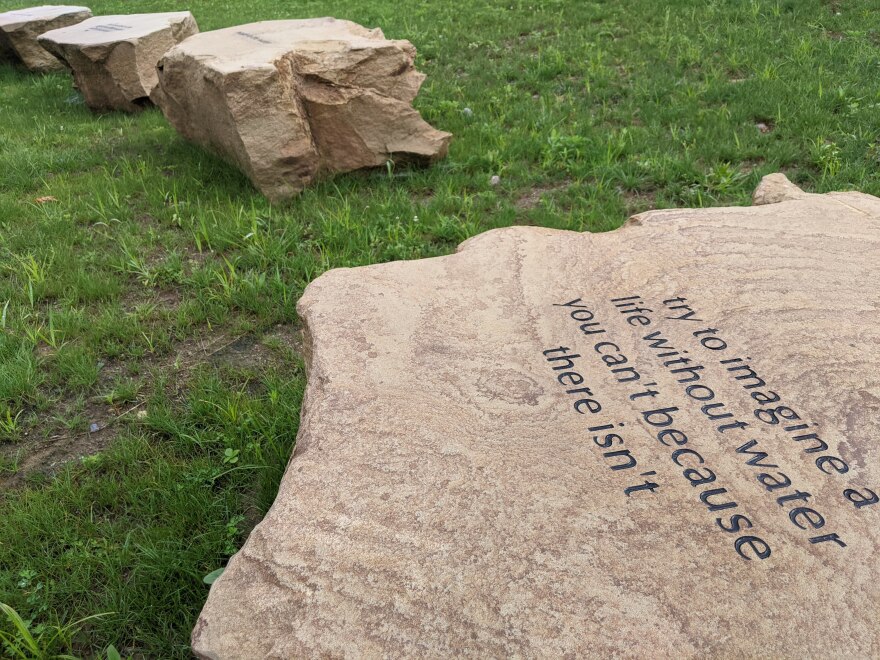Pittsburgh’s combined sewer system was built in the 1800s for a much smaller city, and it is notorious for overflowing: It backs up into people’s basements, floods onto the streets and overflows into the Allegheny, Ohio and Monongahela Rivers. But thanks to collaborations among the city, the Pittsburgh Water and Sewer Authority and other entities, new opportunities to capture stormwater are hidden beneath the green grass in parks.
LISTEN to the story
Across the street from Wightman Park in Squirrel Hill, water moves fast into Pittsburgh’s original combined sewer system. It’s a network of rusty grates, concrete catch-basins and pipes designed to move sewage and rain away from the city to the rivers, as quickly as possible.
But in Wightman Park itself, water moves slowly. It flows from the street into a rain garden, a sort of temporary pond planted with native perennial plants such as bee balm and goldenrod that thrive in both very wet and very dry conditions. The rain garden collects water at the surface, where it seeps down into perforated pipes, then flows into flat underground storage containers that can hold more than 400,000 gallons of water.

“It mimics the way our region naturally handled and captured and managed stormwater,” said Barton Kirk, the ecological engineer who designed the park’s stormwater system. “One of the key parts of designing green infrastructure is really slowing the water down.”
Wightman Park reopened in October 2020 following a multi-year, $4 million renovation led by the city’s Department of Public Works. While much of the budget went to visible park amenities — such as a new baseball diamond, a long slide that extends from the street down into the park, and inclusive, all-abilities play structures — PWSA contributed $1.2 million for green stormwater infrastructure management. It is part of PWSA’s Citywide Green First Plan, a program that emphasizes using green infrastructure to capture and slow stormwater at the surface before it can enter and overwhelm the combined sewer system.
“Because the city is built out, you start to look for open spaces,” said Tony Igwe, senior manager of stormwater for PWSA. “If we can take … this stormwater… and then route it overland and take it to these parks, that would at least take the pressure off the combined sewer system.”

Liberty Green
Liberty Green is another newly opened park with significant underground stormwater infrastructure, enough to capture 4 million gallons of water a year. The $6.5 million park opened in May in the Larimer neighborhood as part of a major revitalization effort led by the city’s Urban Redevelopment Authority.
At Liberty Green, the River Roots art installation, slated to open in the fall, celebrates the history of water in the Larimer neighborhood. Artist Alisha B. Wormsley created the installation from what she learned during a community engagement process that involved visiting schools, churches and meetings of elders.
“Neighborhoods should not have to bear the sole burden of what it means to live in an environment that doesn’t have sound infrastructure.” –Diamonte Walker, Urban Redevelopment Authority
“It was just really a fascinating and beautiful experience for me to hear how everyone felt about water,” Wormsley said. “It brought these stories of after a big rain, running out with no shoes on and dancing in the gutters. … I wanted to create work that really emulated that.”
Wormsley led workshops in the local schools, prompting kids to imagine what kinds of creatures live underwater in the rivers and when it floods. Then she created stone sculptures from their drawings that peek out from among the bioswales designed to capture and slow stormwater. There is a lizard with wings that “flies” underwater, a sea worm with a cloak that reads “love” and a creature with tubes on its head that it uses to breathe.
She also created sound sculptures inspired by the bells of the local church, ringing reeds that change frequency when the bioswales fill with water. She printed neighborhood photos taken by local high schools on colored ceramic tiles. And she created a seating area from stones engraved with quotes about water she collected from neighborhood elders.

Wormsley’s art is a celebration of water, but the park also meets a critical need for stormwater control in the Larimer neighborhood. In 2011, a family in a minivan was killed in a flash flood on Washington Boulevard caused by rains that overwhelmed the sewer system.
“Neighborhoods should not have to bear the sole burden of what it means to live in an environment that doesn’t have sound infrastructure,” said Diamonte Walker, the deputy executive director of the Urban Redevelopment Authority.
Walker said Larimer is a predominantly African-American neighborhood, and the development of green infrastructure at Liberty Green Park also meets racial and environmental justice goals.
“Sometimes we talk about sustainability and that feels inaccessible sometimes to Black communities,” Walker said. “But [with this park], we’re doing something green … and we’re doing it in a way that is aesthetically pleasing and aesthetically reflective of the culture that is there.”
Looking ahead, as the climate changes, more frequent and heavier rains will strain Pittsburgh’s 19th-century sewer system even more, meaning the need for more stormwater infrastructure is growing more urgent. PWSA’s Igwe said PWSA plans more collaborations with the city on parks like Wightman and Liberty Green.
“My sense is that we have to make use of pretty much every tool in the toolbox to solve the problem,” Igwe said. “And these projects like Wightman will be pretty important pieces of whatever we do in the future for stormwater management.”
The next project already is underway: South Side Park will undergo a major renovation beginning next year, with plans to capture stormwater underground, in rain gardens, and in wet meadows.
An Ohio River Community Bands Together to Slow Runoff and Add Greenspace



